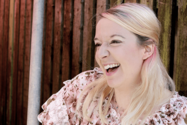The Start of a Journey
Meet Brad Hocking – a final year PhD student at Imperial College London who is passionate about small molecule drug discovery. Hocking is working under the joint supervision of David Mann and Alan Armstrong on projects in covalent fragment based drug discovery. Here, he discusses his work and what inspired his interest in this field.
Stephanie Vine | | 6 min read | Interview

Credit: Interviewee supplied
What first inspired your interest in science?
I’m a final year PhD student at Imperial College London working with David Mann and Alan Armstrong on covalent fragment-based drug discovery projects – I’m finished in the lab (for now!), so by the time this reaches publication I may have submitted my thesis! From when I was quite young, I’d been curious about the natural world and how things worked, so science as a discipline drew me in because it offered answers and ways of investigating them for myself. Since my high school days, my interests have been split between the disciplines of chemistry and biology, so I studied natural sciences with my final two years specializing in synthetic organic chemistry for my undergraduate/MSci.
And what inspired your interest in drug discovery – particularly small molecule drug discovery?
Drug discovery as a field contributes toward improving the future of healthcare and improving people’s length and quality of life, which gives working in the field a good sense of purpose. From the scientific side, I think the practicality of small molecules is that the science is quite well-established, the field is fruitful, and we have a lot of prior blueprints of how to achieve success. The other draw is the creativity that our wealth of synthetic chemistry methodology enables – there’s a huge accessible chemical space available to exploit to really tailor and perfect a molecule’s structure and properties for our purposes. Then there’s the covalent aspect, which adds reactivity to the molecules for extended target engagement and allows us to hit some hard targets, but also comes with its own set of challenges.
Tell us about your work with covalent drug discovery…
My project is funded by the charity Sarcoma UK, and we are taking on a challenging oncology target associated with poor prognosis in several sarcoma subtypes. Sarcomas are typically fast-growing bone and soft tissue cancers with diverse origins. They are very heterogeneous within and across disease subtypes. This means there aren’t a lot of targeted therapies available that are applicable across a range of sarcoma subtypes. There are a few proteins without approved drugs that we can try to target for maximum impact across sarcoma subtypes – of which my target is one. On the project, I’ve been using techniques ranging from fragment screening assays, protein mass spectrometry, protein crystallography and synthetic chemistry.
What have been the most exciting moments of the research so far?
The most exciting moment would have to be when I diffracted one of my most recent protein-fragment adduct crystals at a much higher resolution (1.4 Å) than my previous structures. This was exciting because of how challenging every step of the way is, from obtaining useful protein crystals to correctly cryoprotecting and harvesting them, then getting useful data out of them on the beamline. When I loaded the exciting crystal in question I had high hopes for it (on the beamline camera it was much bigger than the others). When I performed a small screening diffraction, the diffraction images were immediately beautiful, and I knew it was going to be a good quality dataset.
And what have been the biggest challenges?
Less related to technical challenges – but the COVID-19 pandemic couldn’t have happened at a more inconvenient time for me. I started my PhD in February 2020 after a brief break post-MSci. Within a couple of months, I was back out of the lab due to lockdowns. Even after lockdowns there were strict COVID-19 restrictions in place and late shift work patterns.
In addition, learning and applying biochemistry techniques which I had nearly no experience of during this time was particularly challenging!
What analytical equipment has been involved in your work?
I’ve performed most routine 1D and 2D small molecule NMR analysis and IR analysis in synthetic portions of my work, but working in the field of protein modifications means that intact protein LC-MS has been the primary analytical technique I’ve used. I set this up for our group at the Agilent Measurement Suite (AMS) in the Imperial College Molecular Sciences Research Hub (MSRH). I’ve primarily been using an Agilent 6545 Advancebio LC/QTOF set up in the suite – I bring my own C4 column, samples, and solutions to run the instrument. Separately from the AMS, I’ve also had the chance to use a RapidFire high throughput LC system, which is a very cool piece of kit those working in covalent drug discovery are probably aware of or familiar with! They take multi-well plates and can get to throughputs of 3 samples per minute with online desalting for protein screening workflows. It can run a 384 well plate in about 2 hours or so.
It's really important for researchers to have access to good equipment. Researchers want good data, quickly and without having to navigate unreliable or temperamental instrumentation or unnecessarily complex software. It also saves time and cost for funders and means projects can move much faster. The best systems offer those things – accuracy, reproducibility, reliability, throughput – to make the most of research time. The most frustrating experiences come when a costly and fiddly experiment is spoiled or slowed down by broken or inaccurate instrumentation. Another important factor is product aftercare and servicing provided by companies, which can make or break an experience using even the best equipment.
Is it easy for people to use these techniques without analytical skills?
Between my chemistry background and investing in developing my analytical skills and knowledge, things have likely been a lot easier than if I had no analytical skills. If good protocols have been set up, and providing everything works correctly, somebody without any analytical skills could load samples and follow a workflow using any well-designed software to get their data without any issues. But for anything beyond that, it’s important to have a solid understanding of the instrument, method and data being generated to ensure the experiments are rigorous and the data generated is good quality.
Are you considering working in the pharma industry after your studies?
I’m currently applying for grants to continue my current work as a postdoc for a short while. After that, it depends! To try to answer the classic academia versus industry question, I don’t feel too strongly either way, so it will come down to opportunities and where they lie. I do really enjoy teaching and mentoring students in the academic environment, but longer term I think the pharma industry is most likely for me. The pharma industry is well-resourced and tends to have better progression opportunities than academia for primarily lab-based scientists, so I think industry would best suit my life and career goals.
I enjoy working in drug discovery so I would like to stay in this field, and I really enjoy working in the lab day-to-day, so I would hopefully stay lab-based for quite a while longer. I’ve also been considering moving abroad for a stint. My longer-term career goal is to work towards being a project lead or PI and use my interdisciplinary training to tie together broad ranging projects.
Brad Hocking would like to thank Sarcoma UK for funding his work. Sarcoma UK fund research, educate healthcare providers, and provide an important network of support for everyone affected by sarcoma – patients, families and caregivers.

Making great scientific magazines isn’t just about delivering knowledge and high quality content; it’s also about packaging these in the right words to ensure that someone is truly inspired by a topic. My passion is ensuring that our authors’ expertise is presented as a seamless and enjoyable reading experience, whether in print, in digital or on social media. I’ve spent fourteen years writing and editing features for scientific and manufacturing publications, and in making this content engaging and accessible without sacrificing its scientific integrity. There is nothing better than a magazine with great content that feels great to read.



















